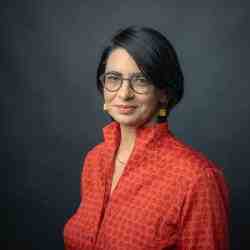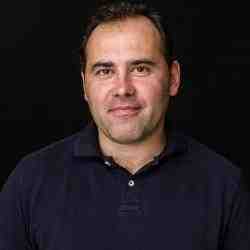Introduction
Kabir Vajpeyi, an architect by qualification, has created a framework to creatively use space and its built elements to make school architecture more conducive to child development. By convincing state governments in India to invest in his idea, he has established an effective delivery mechanism that brings engineers, teachers, and architects together to implement and spread his idea in government schools in rural settings.
The New Idea
Kabir is using the one common element in all rural schools—the physical infrastructure—to improve the quality of education. His Building as Learning Aid (BaLA) idea works on the premise that the scope and dimension of the built environment can contribute to the teaching-learning process. An intrinsically interdisciplinary concept, it combines architecture and design with child development, child behavior, and the pedagogy of learning languages, mathematics, and science.
BaLA uses school spaces (e.g. classrooms, circulation spaces, corridors, steps, and the natural environment) and their constituent built elements (such as floors, walls, ceilings, doors, windows, and furniture), to create a range of affordable learning environments that can be integrated into existing spaces and be actively used as learning resources, with or without the presence of teachers. The three-dimensional space also offers a unique setting for a child to learn because students can have a multisensory experience, as opposed to only engaging in “flat” mediums, such as textbooks or black boards. It also offers the potential to make abstract concepts more concrete from the child’s perspective. For instance, dimensions, shapes, and angles in physical spaces are used to communicate basic concepts of science and mathematics to make learning a more enjoyable and memorable experience for children. In addition to supplementing conventional curricula, BaLA is encouraging teachers to rethink their teaching methods and explore different ways of aiding the child’s learning process.
BaLA translates abstract theories of child development into an actionable pool of simple design improvements and innovations that can be implemented by principals, teachers, and engineers in new and existing schools to enhance their child-friendliness and educational potential. Kabir has begun to implement BaLA by working through Sarva Shiksha Abhiyan (SSA), the Government of India’s flagship educational program to improve education. Working in partnership with eight state governments, Kabir is bringing together designers and engineers with teachers and the community to develop the environment of the school.
The Problem
Children perceive their world through a multisensory experience, especially utilizing their tactile and visual senses. However, the manner in which education takes place, especially in rural government-managed schools, is strictly one-dimensional. Teachers follow a rote method of teaching and, apart from the student’s textbooks, there is little other material to reinforce learning. Moreover, due to administrative duties and limited resources, rural teachers are not always in the classroom; which takes them from teaching up to 20 percent of the time. During their teacher’s absence, children have no access to resources for constructive engagement. All these factors detract from educational opportunities in rural areas, where education is the only way out of abject poverty.
Schools in rural India have limited budgets and resources to train instructors or equip students to teach themselves, yet existing resources are not fully utilized to maximize the learning experience. Every school has a physical building and space. However, these structures are treated as mere shelters for educational activity, rather than assets that encompass and can enhance the learning environment.
The typical architecture of government schools in India has a very classroom-centric approach. Spaces adjacent to classrooms remain underutilized and do not contribute to the learning environment. Most schools continue to function in dilapidated buildings that provide an unstimulating setting for students. The school’s design also drastically affects the teacher’s productive output and classroom management. Studies have conclusively proven that children learn best in a child-friendly, stimulating, and aesthetically pleasing environment.
There is immense opportunity to utilize building spaces. There is room to use creative and practical solutions while repairing or upgrading existing schools or building new buildings. To ensure effective implementation, the aim of education and the design of the built environment needs to be better connected by aligning the social, institutional, administrative, educational, planning, and process domains. The enhancement of the physical environment makes not only an aesthetic improvement, it transforms how the physical space connects with teachers and students.
The Strategy
Kabir’s architectural firm, Vinyas, has worked with educators to create a methodology for using physical space as a tool for child development. These ideas emanate from Kabir’s observation and understanding of natural child behavior in school spaces.
Kabir developed some 150 affordable design and architecture solutions that optimize existing resources to aid child development. He identifies different potential settings for learning in schools and then equips schools with age-appropriate learning resources for them to engage. In the process, indoor and outdoor spaces become resources for learning and fun. For example, a window security grill is designed to help preschool children develop gross motor skills or to help older students conceptualize fractions; a range of angles are marked under a door stop on the floor to explain basic geometry; ceiling fans are painted with color wheels for children to enjoy ever-changing color formations and understand rotational symmetry; the moving shadows of a flag-pole act like a sundial to understand how to measure time; and trees that shed their leaves in winter and are green in summer are planted to make a comfortable outdoor learning space.
Most of Kabir’s design solutions are situated outside classrooms, to create settings children can use independent of teachers. These include tools to estimate distance, dot and grid boards on walls to improve math skills, puzzles and board games on open floor spaces to aid in the development of verbal skills, and sand pits and play equipment to encourage play and nourish empathy.
Since the conceptualization of BaLA in 2002, Vinyas has focused on implementing the BaLA approach in government schools in rural India. To sustain and spread the idea, Kabir believes the idea needs to be communicated to stakeholders at all levels of the government education system. In 2005 Vinyas was able to seize an opportunity that the Government of India’s educational program, SSA presented. Approximately 33 percent of SSA’s annual budget is earmarked for infrastructure development (in fiscal 2011 to 2012 it was approximately INR 20,000 crore or US$324). Acting as a technical partner to the SSA, Vinyas now works with various state governments in the planning and implementation of BaLA.
Vinyas begins the process by organizing an orientation workshop with members representing different segments of the SSA (at the district level or state level, depending on the scale of implementation). This core group includes personnel from the pedagogy, inclusive education, finance, civil works, and administrative departments. The orientation is aimed at formulating the vision constituents to create a “model school” and the importance of an interdisciplinary approach to create a holistic learning environment. It forms the backbone of the planning and implementation of BaLA.
Teachers share curricula to brief the core group of SSA members following the orientation in order to refine relevant BaLA ideas. Members discuss concepts that need reinforcement and undertake field visits to survey existing spaces in schools and observe children and teaching-learning processes. The team then reconvenes to identify common solutions; keeping in mind local skills, materials, and spaces. Finally, solutions are prioritized and systems for implementation are developed.
To leverage their expertise and utilize existing school personnel, Vinyas connects with key persons from the SSA to act as “master trainers” and carry out assessments and implement design solutions in collaboration with other school stakeholders. From this experience, Vinyas develops a detailed set of BaLA drawings and specifications and helps the administration develop the rate analysis for various aspects of work. This becomes a working document for the cost of ongoing projects.
Based on the engineers estimate, funds are directly transferred to village committees (including parents, the panchayat president, and the school principal) responsible for the supervision and the implementation of funds. While the cost of constructing BaLA elements varies from one school to another, the average budget allocated under the SSA for implementation of a BaLA project is about US$5K (INR 2.5 lakhs). In many cases, the officers have raised other funds toward the school development on an as-needed-basis. It takes approximately eight months from planning to implementation, and each school has a unique character.
Through the decentralized planning and implementation process, Vinyas assures engineers, teachers and communities creative ownership over the process, and teachers, engineers, and administrators identify opportunities and solutions. For Kabir, this is critical, as the spaces are not an end in themselves but a strategic entry point to encourage teachers to reassess how learning can take place and to orient teachers toward activity-based learning. The flexible process enables teachers and engineers to invest their creative energies to contextualize and continue to build on the idea. This also improves the likelihood of them using the spaces on an ongoing basis. In several cases, teachers and engineers have come up with a whole range of innovations such as creating open libraries, using puppets for teaching and maps.
Vinyas has worked with the SSA team to develop BaLA initiatives in the states of Karnataka, Gujarat, Himachal Pradesh, Orissa, West Bengal, Jammu, and Kashmir, and Madhya Pradesh and the Union Territory of New Delhi. BaLA has been implemented in approximately 1,200 schools in Himachal Pradesh, 1,000 schools in Gujarat, and 200 schools in Orissa.
As a result of BaLA, there has been an increase in enrollment, higher retention, and attendance in schools. Teachers report an increased willingness among children to come to school and a reduction in vandalism. There have also been several instances of children from private schools moving to government schools after BaLA’s implementation. More importantly BaLA has in many cases triggered a thought process among teachers to explore alternative methods for more effective teaching. The state of Gujarat has for the first time appointed architects to design schools (a task previously undertaken by teachers and engineers).
Kabir is cognizant that BaLA’s effectiveness depends on teachers’ sensitivity to the needs of children and the ways in which they learn. To strengthen BaLA’s process of engaging teachers and principals, Kabir will engage principals who have effectively implemented BaLA as resources to share their visions and formulate new ideas. Kabir is also creating a manual for principals to refer to and open source design tools to help project architects and engineers make decisions.
The Person
Kabir was born into a very creative family—his mother was a dancer and his father was a writer and bureaucrat in the Ministry of Culture. His father was responsible for institutionalizing many platforms for artists in the state of Madhya Pradesh. One such platform was the Bharat Bhavan which brought together different types of artists—poets, dancers, and musicians—to create new possibilities for interdisciplinary collaboration.
Although Kabir grew up in an unusually artistic and creative environment, he was more inclined toward applied science. As a child he worked with his family’s gardener and built many projects, such as a watering system and mini-dam. Kabir continued to take apart and rebuild electronic devices to understand how they worked and to explore the ways in which they could be used.
As a student of architecture, Kabir was extremely active. He questioned examinations that allowed students to assume any site specification to design buildings. To Kabir, this assumption was highly unrealistic and did not push architects to be creative. Keen to get on-site experience, Kabir worked as an intern for a slum rehabilitation project in his third year of college. This proved to be a great learning experience as he began to understand the gaps between the needs of people and the rigid classifications and solutions offered by the government. It also gave him the opportunity to present his idea before government authorities. These interactions created the opportunity for Kabir to attend a workshop conducted by Laurie Baker—an architect renowned for his initiatives in cost-effective energy-efficient architecture with aesthetic sensibility. Kabir recollects this as a transformative experience that made him question much of what he had learned in architecture school.
Kabir was also an active member of the National Association of Students of Architecture forum which organizes annual design challenges for students across India and conducted workshops to enhance their skills. Upon graduation, Kabir joined a reputed architect in Delhi. His second assignment was to repair rural schools in Rajasthan and to ensure the basic minimum needs of the school were met under the government’s Lok Jumbish Project; an innovative education program that brought architects to catalyze improvement in primary education through community participation. This experience helped Kabir understand local architecture, limitations in skills and materials, government processes, and the value of community participation.
After working for about a year and half under the project and about 100 schools in Rajasthan, in 1994 Kabir started his architectural firm, Vinyas. Kabir began to empathize with children for not wanting to come to school after seeing the conditions of the classrooms. While a number of stakeholders attributed absenteeism to social and educational problems, Kabir was deeply convinced that the physical environment of a school needed to play an important positive role in the development of school-aged children.
During this time, one of the teachers asked if it was possible to use pebbles, shells, and broken bangles to make games for children while repairing the floor and walls of the schools. It was this particular question along with the backdrop of other realizations that seeded the idea of BaLA. With support from UNICEF to explore the idea, Kabir brought together a cadre of architects, engineers, teachers, pedagogues, environmentalists, experts in language and culture, child behavior experts, and scientists to refine the idea.
Going forward, Kabir plans to explore interfaces between design and efficacy in other social realms, including health and housing. He is also eager to influence the practices of the architects through content development and advocacy, to help spread BaLA’s approach.



